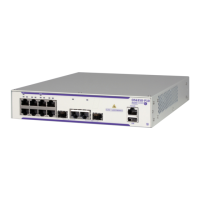Distributed Spanning Tree Commands
page 16-8 OmniSwitch 6250 CLI Reference Guide November 2009
bridge cist protocol
Configures the Spanning Tree protocol for the flat mode Common and Internal Spanning Tree (CIST)
instance (bridge 1).
bridge cist protocol {stp | rstp | mstp}
Syntax Definitions
stp IEEE 802.1D standard Spanning Tree Algorithm and Protocol.
rstp IEEE 802.1w Rapid Spanning Tree Protocol.
mstp IEEE 802.1Q 2005 Multiple Spanning Tree Protocol.
Defaults
RSTP is the default protocol for the flat mode CIST instance and for the 1x1 mode VLAN instance.
Platforms Supported
OmniSwitch 6250
Usage Guidelines
• This command is an explicit Spanning Tree command that only applies to the flat mode CIST instance
regardless of which operating mode (flat or 1x1) or protocol is active on the switch.
• Use this command to select STP, RSTP, or MSTP as the protocol for the flat mode CIST instance.
• Note that selecting MSTP is only an option for the flat mode CIST instance and is required to config-
ure Multiple Spanning Tree Instances (MSTI).
• MSTP is only active when the switch is operating in the flat Spanning Tree mode. STP and RSTP are
active when the switch is operating in either the flat or 1x1 Spanning Tree mode.
• Note that when changing the protocol to/from MSTP, the bridge priority and port path cost values for
the flat mode CIST instance are reset to their default values. However, if the path cost mode was set to
32-bit prior to the protocol change, the path cost is not reset to its default value. See the bridge path
cost mode command page for more information.
• If the switch is running in 1x1 mode when this command is used, the specified protocol is not active for
the CIST instance until the operating mode for the switch is changed to the flat mode.
• Note that when a configuration snapshot is taken of the switch, all Spanning Tree commands are saved
in their explicit format.
Examples
-> bridge cist protocol rstp
-> bridge cist protocol mstp
-> bridge cist protocol stp

